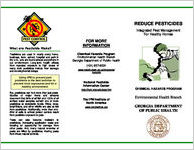What are Pesticide Risks?
Pesticides are used in nearly every home, business, farm, school, hospital and park in the U.S., and are found almost everywhere in our environment. Long-term health effects from repeated exposure to high doses of many toxic pesticides include liver damage and developmental delays.
Using IPM to prevent pest problems is the best solution to prevent toxic exposures and for a
healthy environment.
But, pesticides can hurt more than just pests. Studies of major rivers and streams document that 96% of all fish and 100% of all surface water samples contain one or more pesticides at detectable levels. Birds, bees, amphibians, and other wildlife are also at risk from pesticides. Additionally, more than onethird of calls to animal poison centers result from pesticide exposure to pets.
Pests can also become resistant to pesticides, increasing application costs and creating an opportunity for damage from other pests. And, many natural enemies of pests are killed by pesticides, freeing pests from these natural controls.
FOR MORE INFORMATION
Chemical Hazards Program Environmental Health Branch Georgia Department of Public Health
(404) 657-6534
www.health.state.ga.us/programs/ hazards
National Pesticide Information Center
http://npic.orst.edu/pest.htm
The IPM Institute of North America
www.ipminstitute.org
REDUCE PESTICIDES
Integrated Pest Management For Healthy Homes
CHEMICAL HAZARDS PROGRAM
Environmental Health Branch GEORGIA DEPARTMENT
OF PUBLIC HEALTH
What is Integrated Pest Management?
Integrated Pest Management, or IPM, is a plan that solves pest problems caused by insects, weeds, germs, or any other pest. The goal of IPM is to prevent, reduce, and eliminate pests. This is accomplished by using a variety of methods that keep pests under control in a way that's affordable, effective and has the least impact on people and on the environment.
To control pests, IPM uses the most current information on the life cycles of pests and their interaction with the environment. IPM takes advantage of all pest management options including limited use of toxic chemical applications, and using more species-specific chemicals, biological controls, and trapping.
Every home has many toxic chemicals. A number of products in kitchens, bathrooms, basements, utility sheds, and workshops contain chemicals that can threaten human health and damage the environment. The challenge for today's consumer is to reduce the use of hazardous products in the home. What can you do to meet this challenge?
Preventing Pests
DISCOURAGE PESTS FROM BECOMING HOUSE GUESTS
1. Know the enemy 2. Deny food, water and shelter
Remember 3. The key to managing pest control is
sanitation!
Eliminate the comfort, water, and nutrients pests need:
Vegetation, shrubs, and mulch are kept at least one foot away from building structures.
The problem or pest is identified before taking action.
Cracks and crevices in walls, floors and pavement are filled or eliminated.
Food-contaminated items and surfaces are cleaned at the end of each day.
Garbage cans and dumpsters are emptied and cleaned regularly.
Animal waste is collected and disposed of at least once a week.
If chemical pesticides are necessary, use spot treatments rather than area-wide applications.
There are Four Steps to IPM
1) Set Action Thresholds
Maintaining a healthy environment does not mean zero pests. Decide on what is an acceptable amount of pests and assess pest threat levels.
2) Monitor and Identify Pests
Not all insects, weeds, and other living organisms require control. Many are harmless, and some are beneficial. Monitoring and identification reduce or eliminate the need for many chemical pesticides, and prevent the use of the wrong kind, or too much, of a pesticide.
3) Apply Prevention (Prevent a Suitable Environment)
As a first line of pest control, IPM plans manage the garden, lawn or indoor space to prevent pests from becoming a threat. Some common school areas suitable for IPM are: offices, food service and storage areas, custodial closets, classrooms, gyms and locker rooms, teacher's lounge and landscaping.
4) Use Pest Control
Once action thresholds, monitoring, identification and preventive methods are no longer effective or available, IPM applies and combines lower risk pest control measures such as:
pest-specific chemicals that affect growth and reproduction
natural predators like lady bugs and praying mantises
mechanical control including trapping and weeding
